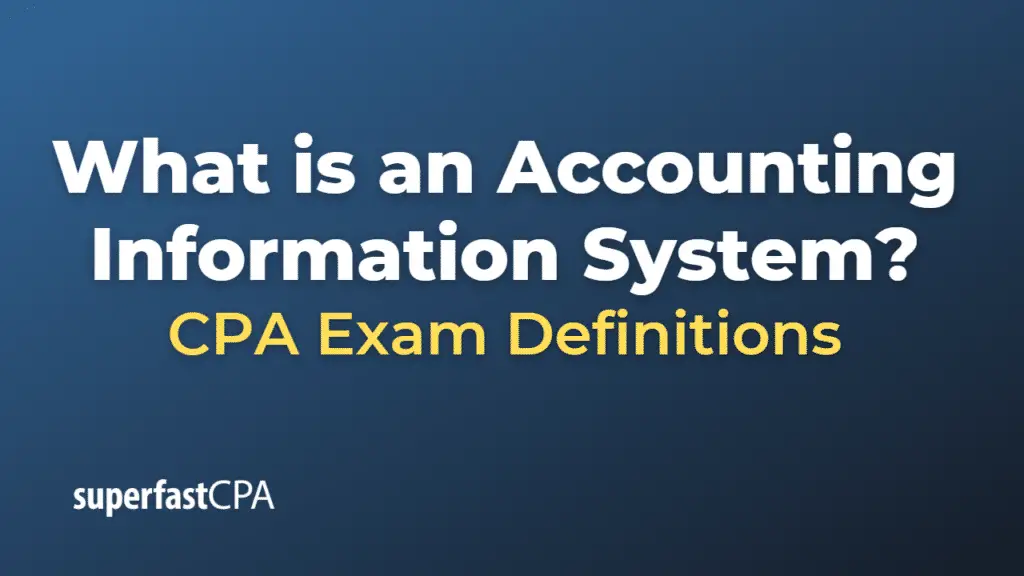Accounting Information System
An Accounting Information System (AIS) is a computerized system designed to collect, store, process, and report financial data related to a company’s or organization’s business transactions. AIS helps businesses maintain accurate financial records, streamline accounting processes, and comply with regulatory requirements. The main purpose of an AIS is to support the functions of accounting, financial reporting, and decision-making for management, investors, and other stakeholders.
An effective AIS typically includes the following components:
- People: The users of the AIS, such as accountants, bookkeepers, financial managers, and other employees responsible for managing and processing financial transactions.
- Procedures: The set of rules, policies, and guidelines that govern how the AIS operates, including data entry, data processing, error detection and correction, financial reporting, and internal controls.
- Data: The financial information that is collected, stored, and processed within the AIS, such as sales transactions, expenses, inventory data, payroll information, and other relevant financial data.
- Software: The computer programs and applications used to process, store, and manage the financial data within the AIS, such as accounting software packages (e.g., QuickBooks, Sage, Xero) or Enterprise Resource Planning (ERP) systems.
- Information Technology Infrastructure: The hardware, networking equipment, and other IT resources that support the operation of the AIS, such as servers, computers, storage devices, and communication networks.
- Internal Controls: The policies, procedures, and mechanisms in place to ensure the accuracy, reliability, and security of the AIS, such as user access controls, data backup and recovery processes, and segregation of duties.
An AIS can be customized to meet the specific needs of a company or organization, depending on its size, industry, and regulatory requirements. Implementing an effective AIS can help businesses improve their financial management, enhance operational efficiency, and facilitate better decision-making through timely and accurate financial reporting.
Example of an Accounting Information System
Let’s consider a hypothetical example of a small retail business called “TrendyStyles Boutique” that decides to implement an Accounting Information System (AIS) to manage its financial data and streamline its accounting processes.
- People: The users of the AIS at TrendyStyles Boutique include the owner, the store manager, the accountant, and the sales associates. Each user has different responsibilities and levels of access to the system, based on their roles and duties.
- Procedures: TrendyStyles Boutique establishes procedures for using the AIS, such as entering sales transactions, managing inventory, recording expenses, reconciling bank accounts, and generating financial reports. The procedures also include guidelines for detecting and correcting errors and ensuring data accuracy and consistency.
- Data: The AIS collects and stores various types of financial data for TrendyStyles Boutique, including sales transactions, customer information, inventory levels, supplier invoices, payroll data, and other relevant financial information.
- Software: The boutique chooses a cloud-based accounting software package, such as QuickBooks Online or Xero, that is designed for small businesses and offers features like invoicing, inventory management, expense tracking, and financial reporting. The software automates many of the accounting tasks, reducing the potential for errors and saving time.
- Information Technology Infrastructure: TrendyStyles Boutique uses computers, tablets, and smartphones to access the AIS, along with a reliable internet connection to ensure uninterrupted access to the cloud-based accounting software. They also have a point-of-sale (POS) system integrated with the AIS to record sales transactions in real-time.
- Internal Controls: The owner of TrendyStyles Boutique implements internal controls within the AIS, such as user access controls (e.g., unique usernames and passwords), segregation of duties (e.g., different employees responsible for recording transactions and reconciling accounts), and regular data backup and recovery procedures to protect against data loss or unauthorized access.
By implementing an AIS, TrendyStyles Boutique can efficiently manage its financial data, automate accounting processes, and generate accurate financial reports. This allows the owner and the management team to make informed business decisions, monitor the company’s financial performance, and ensure compliance with tax and regulatory requirements.













